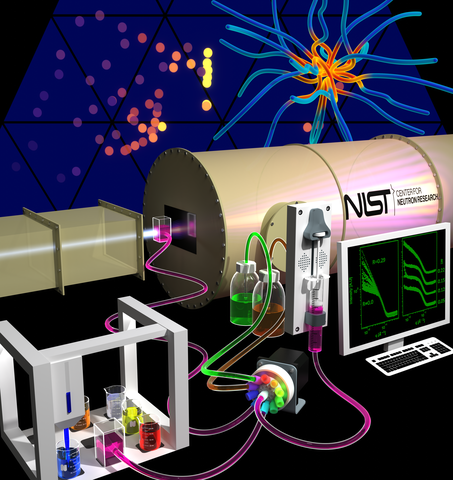Autonomous Formulation Lab (AFL)

The Autonomous Formulation Laboratory is a joint program between the nSoft consortium, NCNR, and NIST's Materials Measurement Lab focused on accelerating materials discovery and formulation optimization through artificial intelligence (AI) and machine learning (ML) directed, multimodal scattering experiments. The core of the AFL platform is an open source, NCNR-developed platform to prepare liquid mixtures via pipetting, transfer those mixtures to a measurement cell, perform a SANS (or SAXS or other method) experiment, and provide the data to an AI guidance server.
Formulation engineering is at the core of soft materials-based products that cut across industry and everyday life: paints, vaccines, fuels, and shampoos are just a few examples of products that are formulated with tens to hundreds of individual components. Companies frequently need to (re)formulate products to address environmental regulations, reduce cost, improve performance, etc. Frequently, changes in one component (for example, replacing a fragrance) can cause complex structural changes that affect the stability bounds of a given product and ultimately impact performance in unexpected ways. The AFL seeks to map changes to underlying structure to enable rational formulation design.
The AFL is being developed by NIST NCNR and MML staff with beamtime from other facilities such as the Cornell CHESS synchrotron, the Advanced Photon Source at Argonne, the ISIS Neutron source in the UK, and the Swiss spallation neutron source at the Paul Scherrer Institute in Switzerland. The AFL platform provides manual/programmed grid and autonomous, AI-driven measurements across multiple techniques and user facilities. Key neutron capabilities will be to automatically determine compositions for contrast matched samples, and determine multi-component phase maps for surfactant formulations.
The AFL is a radically open platform; our code and instrument designs are public on GitHub in the AFL-automation and AFL-hardware packages. The design of the platform is further documented in our 2023 Chemistry of Materials publication, which includes extensive details in the Supporting Information, and in forthcoming papers.
If you are interested in replicating the AFL, or using it at the NCNR, please reach out to Dr. Peter Beaucage or Dr. Tyler Martin (contact info below) for more details!
Multiplatform Facility
- Common approach for industrial autonomous facilities
- Neutron scattering central technique
- Orthogonal data developed to refine complex, multiparameter models of neutron data
Customizable to application
- Member-specific mixing, sample environment, and process parameters
- Interoperable data formats
- All operations and data modeling automated
Scheduling and Process Control
- Consistent, modular sample environment, data handling, and server software across platforms
- Common server framework
- Auto-discovery of component functionality
- Scheduling with component queues
- Run multiple instruments simultaneously or in series
Autonomous Measurements
- Contrast matched component determination
- Phase compositions for complex formulations
Milestones achieved during the unexpected outage
- Within three weeks of the incident, the AFL was relocated to MML's liquid-metal SAXS system, including the design of a new sample cell, software interfacing, and first measurements. With continuous instrument access the AFL has run as long as 5 weeks uninterrupted, automatically preparing and measuring hundreds of discrete samples
- The AFL travelled to numerous other neutron sources and synchrotrons, where we measured thousands of compositions across several systems relevant to nSoft members and tested the feasibility of new operating modes.
- Additional measurement modalities have been prototyped to lay the groundwork for multimodal data integration, including spectroscopy, rheology, and optical imaging
- The liquid sample loading platform has been completely redesigned, realizing a ~50x decrease in sample loading cycle times with reduced potential for fouling and inter-sample crossover.
- Designed a web-based control dashboard for the AFL (Elizabeth Perez, an MC-Intern)
- Designed a sample metadata tracking database for the AFL (SHIP student Aaron Tian)
- The AFL team has developed working relationships with many neutron and X-ray peer facilities including the Paul Scherrer Institute, UKRI ISIS Neutron and Muon Source, the Cornell CHESS synchrotron, the Advanced Photon Source at Argonne National Lab, and the National Synchrotron Light Source-II at Brookhaven National Lab for beam-time, collaborations, and other long-term access models. These conversations are laying the groundwork for activities that will occur during the cold source upgrade and potential future access modes.
Contacts
nSoft
-
(301) 975-8866
-
(301) 975-8367
-
(301) 975-4624

